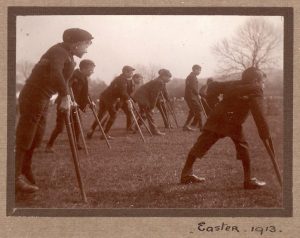Disability in the History Curriculum
In yesterdays post about diversity, I wrote almost entirely about ethnicity. This was partly because that is the aspect of Diversity with which most people resonate the most and partly to see if anyone challenged the glaring omissions from the post. Luckily one person did message me and discussed additional areas. There was also a blog about Diversity that Glenn Carter published on his website which covered further areas.
The problem is that people do tend to view Diversity from a racial or ethnic perspective. Even on that, it is not particularly ‘right’ or ‘balanced’. Yesterday I made a tally of the number of times I saw a comment on social media that said something along the lines of ‘reflects my class’. I stopped at 50. Going to be blunt here: you cover the racial diversity in your own class, and you are reinforcing the problem. Cover diversity in our society, not your class of 30 people.
I said there that racial diversity is not particularly right or balanced. It is not. The resourcing and curriculum time spent on different ethnic groups simply does not reflect the actual makeup of society. There are all sorts of reasons for that, such as the current Black Lives Matters protests, but it is not representative of ethnic proportions within the UK.
From the Institute of Race Relations:
The most recent Census in 2011 highlights that in England and Wales, 80 per cent of the population were white British. Asian (Pakistani, Indian, Bangladeshi, other) ‘groups’ made up 6.8 per cent of the population; black groups 3.4 per cent; Chinese groups 0.7 cent, Arab groups 0.4 per cent and other groups 0.6 per cent.
So, in very simple terms, there needs to be a realisation that 16.6% of the population probably has very little, if any, curriculum content that relates to their heritage. That is wrong. That also assumes that Black History IS covered as I have never come across a school yet that does not have at least some inclusion of Black History in the curriculum.
But Diversity is not just about race. Those statistics show that no racial group makes up the largest minority grouping in the UK. If you aim at a Diverse curriculum, surely you include lots on the biggest minority group? After all, one in five people are part of that grouping and there is documented history of it going back as far as records go so no reason whatsoever not to incorporate it. Biggest minority grouping? Disabled people. By a long way. There are as many Disabled people in the UK as there are people from all ethnic minorities combined. You will see Disabled people every working day: you might not realise it though.

At first thought, many teachers will possibly think that it is hard to find examples of where this could be incorporated into schemes of work. The opposite is true, you could swamp the curriculum with it so easily. How? You ever mentioned a war in a history lesson? Or the Royal Family? Or the poor? Or taught Medicine through time? Or been asked by pupils about Covid19? All of those and more provide evidence of Disability in history. Plus there are many other stories and examples that fit in quite nicely with existing units of work.
Examples:
Medieval
Leper Houses
Alms Houses
Monastery Hospitals
‘The natural fool’
Bethlem Hospital (later known as Bedlam)
Pilgrimage for cures
The Kings Touch
Battle Wounds and Battlefield Surgery
1485-1660
Impotent Poor
‘Natural Fools’ at court -Will Somer and Jane the Fool
Impact of dissolution of monasteries
Battlefield wounds and surgery
Religious meanings assigned to cognitive and neurological disabilities
1660-1832
Scientific developments changed the perceptions of some disabilities. Fits in with Age of Enlightenment and Scientific Revolution
Poor relief for destitute disabled persons
Bethlem develops
Royal Chelsea and Greenwich hospitals for disabled soldiers
Development of Battlefield Surgery and treatments of long-term wounds
Voluntary movements emerge, such as the Quakers who established York Retreat
The first school for the blind or dumb
The emergence of private ‘madhouses’
Peter the Wild Boy – taken to the court of George I
1832-1914
Pauper lunatic asylums
Workhouses
Professional alienists (now called psychiatrists)
Special Schools established
Emergence of philanthropic and charitable trusts
Guild of the Brave Poor Things
Henry Fawcett. Statesman, Academic, Postmaster-General – blind
1914-45
Eugenics popular as a theory in the early 20th century
2 million servicemen had been disabled during the First World War
Plastic Surgery developed
Prosthetics
New Almshouses built for servicemen
Disability colonies established
Sunshine Homes
Open-Air Schools
Disabled People in History
Albert Einstein, Woodrow Wilson, Alexander Graham Bell, Thomas Edison, FD Roosevelt, John Milton, Lord Byron, Lord Nelson, Beethoven, Stephen Hawkins, Walt Disney, Lenin, Caligula, Prince John of the UK who only died of his disabilities 100 years ago, Edward Lear, Julius Caesar, Socrates, Joan of Arc, Alfred Nobel, Alfred the Great, Charles Dickens… and many more
UK Link
https://historicengland.org.uk/research/inclusive-heritage/disability-history/
US Examples
Are explored in this pdf file – https://uk.sagepub.com/sites/default/files/upm-binaries/26491_Chapter_1_Historical_Background_of_Disabilities.pdf
Leave a Reply Cancel reply
You must be logged in to post a comment.